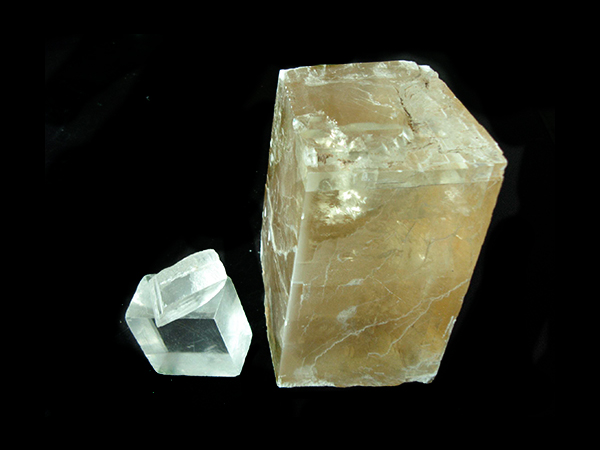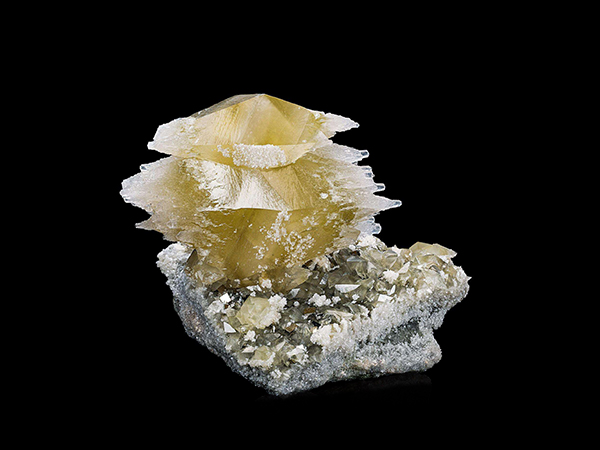CALCITE

Knocking calcite can get a lot of square pieces, hence the name calcite.
basic introduction
Calcite is a calcium carbonate mineral, the most common of which is natural calcium carbonate. Therefore, calcite is a widely distributed mineral. Calcite has a variety of crystal shapes, and the aggregates thereof may be a cluster of crystals, or may be granular, massive, fibrous, stalactite, earthy, and the like.
Knocking calcite can get a lot of square pieces, so the name is solved. The color of calcite varies depending on the impurities contained in it, such as light yellow, light red, brown black, etc. when containing iron and manganese. But generally it is mostly white or colorless. The colorless and transparent calcite is also called the ice stone. This kind of calcite has a wonderful feature, that is, it can see that the object has a double image.
Therefore, ice stone is an important optical material. Calcite is the main mineral of limestone and marble, and has many uses in production and life. We know that limestone can form caves, and stalactites, stalagmites, white marbles, etc. in the caves are actually composed of calcite.
Calcite often contains Mn, Fe, Zn, Mg, Pb, Sr, Ba, Co, TR and other isomorphic substitutes; when they reach a certain amount, they can form manganese calcite, iron calcite, zinc calcite, magnesium calcite, etc. variant. In addition, brucite, dolomite, iron hydroxide and mechanical mixtures such as oxides, sulfides and quartz are also common in crystals.
Trigonal crystal system; common intact crystals. There are various forms, and there are more than 600 different shapes. It is mainly in the form of parallel and parallel development of plate-like and parallel-shaped rhombohedron or complex trigonal ortho-triangular body.
Calcite often forms contact twin crystals, and more often forms polycrystalline twin crystals. The orientation of this polycrystalline double crystal grain on the cleavage plane is different from that of dolomite. In nature, the appearance of such polycrystalline twin crystals can be used. It shows that after the formation of calcite, it has been subjected to geological stress.
ingredient
Calcite, chemical composition CaO accounted for 56.03%, CO2 accounted for 43.97%, often containing Mn and Fe, and sometimes containing Sr. Its name comes from its easy to break along its cleavage into small square pieces. Li Shizhen thinks that calcite "in the "Compendium of Materia Medica" is like an anhydrite block, hitting the block, the wall is bright, the name is also calcite."
Calcite can often see good crystals. Common crystal forms include hexagonal column {1010} and rhombohedron {0112} polymorphism, complex trigonometric triangular face {2131}, rhombohedron {0112}, etc., rhombohedron {1011} simplex Crystals (like the cleavage block shape) are relatively rare;
They are common in (0112) polycrystalline twin crystals, which are the result of stress; also appear as {0001} contact twins. The aggregate is granular, dense block, stalactite, tuberculosis, scorpion, bean, earthy (white).
The color of calcite varies depending on the impurities contained therein. For example, when iron and manganese are contained, it is light yellow, light red, brownish black, etc., but generally white or colorless. The colorless and transparent calcite is also called the ice stone (named after the birth of Iceland [3]).
This kind of calcite has a wonderful feature, that is, through it, the object can be seen as a double image. Therefore, the ice stone is Important optical material. Calcite is the main mineral of limestone and marble, and has many uses in production and life. We know that limestone can form caves, and stalactites, stalagmites, white marbles, etc. in the caves are actually composed of calcite.
On August 17, 2004, Xu's Jewelry Studio in Guiyang, Guizhou Province donated the world's two largest calcite gemstones to the China Geological Museum. One of the stones is a pale yellow, overturned Portuguese-style calcite gemstone weighing 172.5 carats;
another
It is a golden brown, close-shaped hexagonal calcite gemstone weighing 84 carats. Both gems weigh more than the 75.8-carat golden brown-stepped enamel-type calcite jewel in the Smithsonian Museum. These two calcite gems were successfully researched by Xu's Jewelry Studio in Guiyang from 2000 to 2002, filling the gap in the processing of Chinese brilliant calcite gemstones.
It usually contains Mn, Fe, Zn, Mg, Pb, Sr, Ba, Co, TR and other similar materials. When they reach a certain amount, they can form manganese calcite, iron calcite, zinc calcite, magnesium calcite and other varieties. . In addition, brucite, dolomite, iron hydroxide and mechanical mixtures such as oxides, sulfides and quartz are also common in crystals.

Calcite is widely distributed in nature.
A large limestone formation is often deposited in shallow seas or lakes.
Groundwater can dissolve limestone and can also form calcite, such as stalactites, stalagmites, travertines, etc. The groundwater that is active in the soil is near the surface of the diving surface, and often forms calcite tuberculosis distributed along a certain horizontal plane. The geological workers are used to call calcareous tuberculosis.
Calcite veins containing or without ore are often formed in hydrothermal activity. In the crystal cavity, there are often good crystals.
Among the carbonates formed by magma, calcite often accounts for about 80%.
In addition, calcite is also used as a cement for clastic sedimentary rocks, and minerals after the alteration of basic magmatic rocks participate in various rocks. Due to groundwater activity, calcite veins are often filled in the fissures of various rocks.
Limestone formed by sedimentation, in the case of regional metamorphism or contact metamorphism, the calcite is often recrystallized to form a coarse aggregate of calcite, the marble.
Crystal structure
Trigonal system; -R c; rhombohedral unit cell: arh=0.637 nm, α=46°07′; Z=2; if converted to hexagonal (double body) lattice, then: ah=0.499 nm, ch=1.706 Nm; Z = 6.The calcite structure is described in the overview section of Mineralogy Chapter 22.
The crystal structure of calcite can be derived from the NaCl structure. It is envisaged that the crystal structure of NaCl is flattened along a cubic axis, and the carbonate ions and Ca ions are respectively placed at the positions of Cl ions and Na ions of the deformed NaCl structure, and the plane triangular carbonate ions are perpendicular to the cubic axis.
Arrangement, that is, the crystal structure of calcite (see [Calculate crystal structure]) is usually intact crystal. There are various forms, and there are more than 600 different shapes. It is mainly in the form of parallel and [0001] developed columnar and parallel {0001} developed plate-like and various states of rhombohedron or complex trigonal scalenohedron (Fig. H-1). Calcite often forms a contact twin crystal according to (0001), and more often forms a polycrystalline twin crystal according to (012).
The orientation of this polycrystalline double crystal grain on the cleavage plane is different from that of dolomite. In nature, this kind of polycrystalline film The appearance of twin crystals can be used to illustrate the role of geological stress after the formation of calcite.
Colorless or white, sometimes dyed with Fe, Mn, Cu and other elements into light yellow, light red, purple, brown black. The colorless and transparent calcite is called icespar. The cleavage {101} is completely; under the influence of stress, it slips into a split along the {012} polycrystalline twin direction. Hardness 3. The relative density is 2.6 to 2.9. Some calcites have an optical rotation.
Calcite is the most important rock-forming ore in the earth's crust. English name: calcite, is a variable rock, carbonate mineral, chemical composition:
CaCO3, trigonal, three groups of complete cleavage, fracture; glass luster. Completely transparent to translucent, ordinary white or colorless, due to other The metallic coloring elements are light red, light yellow, light tea, rose red, purple, various colors, streaks white, hardness 2.704-3.00, specific gravity 2.6 ~ 2.8, violent foaming in dilute hydrochloric acid, very pure and completely transparent The crystal, commonly known as the Iceland Spar, has a strong birefringence function and the largest polarized light function is a natural crystal that cannot be manufactured or replaced by humans.
use
Calcite has a variety of crystal shapes, and the main mineral of limestone, marble and beautiful stalactites is calcite. Travertine can be deposited in spring water, and it is also a secondary mineral in igneous rock. In the almond hole of basalt flow, the fracture of sedimentary rock is often filled with calcite to form fine veins, or through biological effects, to shells or The way the rock reef is produced.
Because of its birefringence, the ice stone is often used in polarizing prisms. If it is cut into a column in a certain way, it can be used as a prism of a microscope to detect the optical properties of minerals. The quality requirements must be: colorless and transparent, and no bubbles inside.
Or cracks, without twinning or distortion, 0.5吋 (12.5mm) cube or more. General calcite is used in industrial raw materials such as chemicals and cement.
Calcite is used as a flux in the metallurgical industry and used in the construction industry to produce cement and lime. Also used in plastics, paper, toothpaste. Used as a filling additive in foods. The addition of calcite to the glass production results in a glass that becomes translucent and is particularly suitable for use as a glass shade.
Calcite is found in limestone mountains. It is widely found in the Tertiary and Quaternary limestones, and metamorphic rock deposits. Calcite is the earth's ore-forming ore, accounting for more than 40% of the total crust, and its type is not less than 200 species. Representative places are China, Mexico, Britain, France, the United States, and Germany. All the countries in the world are mines.
Calcite is divided into generous solution and small square solution, and ice stone. China's calcite is mainly distributed in Guangxi, Jiangxi, and Hunan. Guangxi western stone is famous in the domestic market for its high whiteness and low acid insoluble matter. Calcite will also be found in the northeastern part of North China, but often accompanied by dolomite. The whiteness is generally below 94, and the acid insolubles are too high.
colour
Beige Calcite beige calcite
Blue Calcite Blue Calcite
Cobaltian Calcite Cobalt Calcite (South Africa)
Green Calcite Green Calcite (China)
Golden Calcite Gold Calcite (China)
Orange Calcite Orange Calcite (Canada, China. Mexico)
Utah Honeycomb Calcite Utah Beehive Calcite
Identification method
As a common carbonate mineral, calcite is widely found in nature. In the hand specimen, it is usually grayish white to white, showing three groups of complete cleavage; dripping hydrochloric acid strongly foaming; hardness is less than the knife. Under single polarization, the twin crystal of calcite is parallel to the long diagonal of the diamond crystal. Advanced white interference colors can be seen under orthogonal polarization. In the cast flakes, it is usually dyed with a mixture of alizarin red and potassium ferricyanide, and the calcite is dyed red.
Collection information
Picture description: continuous crystal; grayish white; streak white; colorless and transparent is ice continent stone, poor color transparency; glass luster; hardness 2.50 ~ 3.75; specific gravity 2.6 ~ 2.9g/cm3; {1011} complete.
